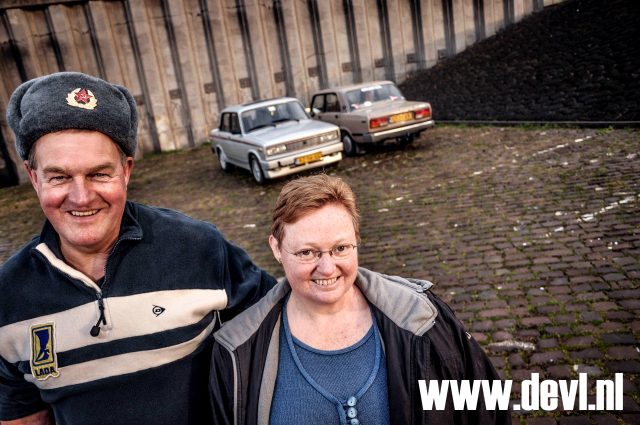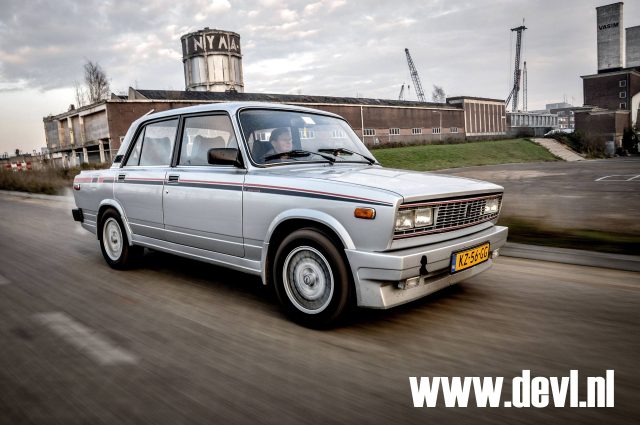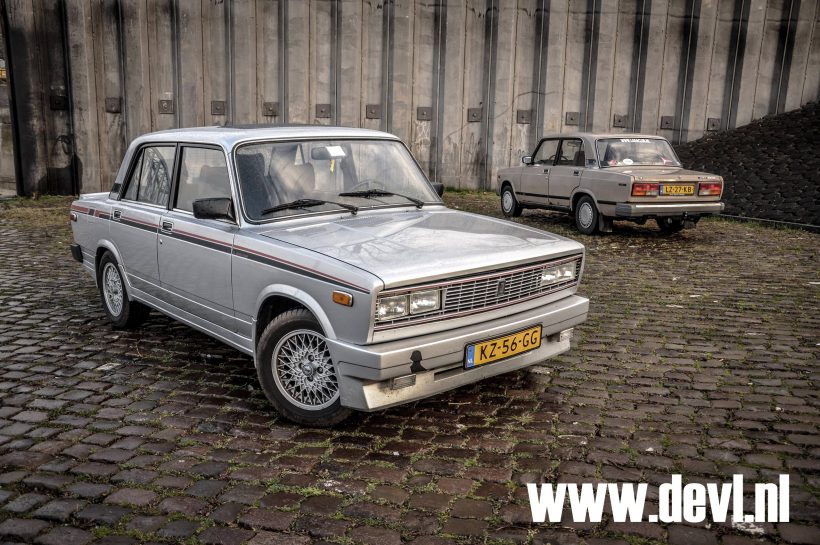Vaztaztic.
That’s how a drunk would sound, trying to pronounce “fantastic”. It’s a nice reference to AvtoVAZ. That stands for Avtomobilny Vozhsky Avtomobilny Zavod, but it’s a little too complicated. Plus, it is something of a pleonasm, because when you translate it you get “Automobile Wolga Automobile Factory”. Right. Apparently them in Togliatti, Russia, found it tob e a bit complicated too, because the factory became known by its trade name, Lada. In Russian, Lada means “ship”, which can bes een in the logo on the cars. The city of Togliatti is a story in itself. It was founded in the eighteenth century, and named after the nearby fortress of Stavropol. The city became known as Stavropol-on-the-Volga, because elsewhere in Russia there’s another city that goes by the name of Stavropol. In the 1950’s a dam was constructed in the Wolga. The reservoir thus created threatend to turn Stavropol-on-the-Volga into Stavropol-in-the-Volga, so the whole city was rebuilt at a safer place. In 1964 it was named after Italian communist Palmiro Togliatti. The AvtoVAZ-factory was built as a cooperation between Italy – Fiat – and Russia. The district around the factory, Novy Gorod, was created to be able to lodge the factory workers. Lada’s origin is a rich source for stories in itself, but the question remains: who gets drunk with happiness from a Lada? Well, Marten and Gonny Post for example.

They bought their first Lada in the 1980’s. That was an economic choice, like many people made it in that time. In stitches with laughter they remember that time. Their daughter, in her teens, refused to be dropped of at the school gate, scared of being seen in a Lada. Marten refused to give her her way, and made a point of stopped right at said gate. “We bought a Lada at the time because it was cheap and sound”, they say. What started as a down-to-earth, sensible choice soon became much more than that. 25 years on, Marten and Gonny still drive a Lada. Not because they have to, but because they can. They love it, so much is clear. “When you drive a Lada, you drive something that stands out”, Gonny says, “we Lada-drivers greet each other on the road. It’s a feeling of unitedness behind the wheel. On top of that: they’re just very good cars, a Lada has never lef tus stranded!” Since 1983, Marten and Gonny went through about nine Lada’s from the 1200- and 2100-series. Right now they own two: one fort he daily chores, and one fort he hell of it!
Their daily workhorse is a 1985 Lada 2107. Some years ago Marten bought another Lada, as an extra. That one was a 2105. Fans know the 2105 is the “base model”, the 2107 is the more luxurious car while thee state is called 2104. Martens 2105 is however all but a base model. This 1981 2105 spent 24 years of its existence in a showroom, as an exhibit. The reason fort hat is clear: this car has been rigorously tuned, to the fashion of its day. A new front with double headlight was installed, as were different bumpers, sideskirts, a rear spoiler, fancy striping and 14-inch honeycombe wheels. The interior was improved as well. Its modern radio-cassette combination was enhanced by an improved centre-console, a more sportive gear lever and new clocks and gauges. There it becomes obvious the tuner was raiding Fiats parts bin, because all the water, fuel and oil-pressure gauge all come from Italian “Veglia”, the clock stems from an Alfa Romeo and the speedometer and rev counter proudly state “Fiat”. It should say that on the engine too, because the 1.6-litre with double overhead camshafts is also of Italian origin. It comes from a Fiat 131 SuperMirafiori and dispatches 95 horsepower tot he rear wheels of the Lada. “It shifts a bit more rigidly but it’s much faster than a standard 2105”, Marten says. Doesn’t he, Lada-lover that he is, think this form of tuning is complete and utter sacrilege? “Not at all! This Lada-was based on a Fiat-platform anyway, so there is no sacrilege. Besides, Lada isn’t quite sacred anyway, so it doesn’t matter!”

In Holland the Lada is a dying species. The brand has a shaky image at best. Later models like the Samara, 2110, Kalina and Priora didn’t quite set the sales charts alight. The paint quality, finish, performance, emission, fuel consumption and design lagged behind their western competition by some margin. Even the lower price couldn’t make the difference. Stories about Lada can be a bit exaggerated thought. Of course, if you think the aforementioned is important for a car, you will find loads of better cars on the market. But still, in the basis a Lada is a solid, reliable car that will be easy and cheap to fix because of its simple technology. They don’t call Lada’s “Russian Mercedes” for nothing. Marten refers to a Russian saying, that says something like “as your life, so is your car”. Think about it. Unbreakable, with a strong character, who wouldn’t want to be like that? Wouldn’t that be Vaztaztic?

The story of the Post family and their Lada’s was published in Youngtimer Magazine in 2012.
